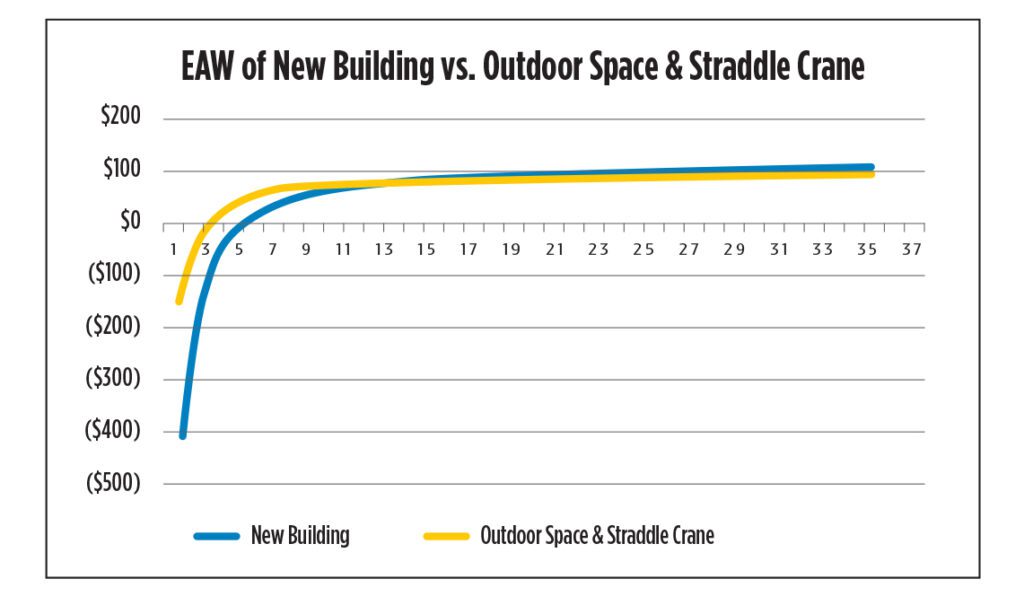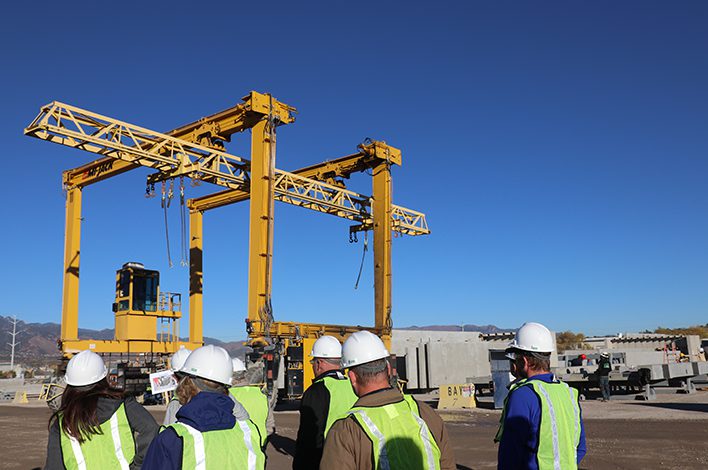The precast concrete market is expected to grow 6.6% by 2027. This trend may have you wondering if it’s time to expand and invest in your company.
For precast manufacturers, and most manufacturing businesses, when and what capital investment is needed to continue meeting the mission and vision of the company is of paramount importance – not a decision to be made without due diligence. Comparing alternatives by applying engineering economy is a methodical and structured approach to deciding with confidence.
What is Engineering Economy?
Ted Eschenbach in his book, “Engineering Economy: Applying Theory to Practice,” defines engineering economy as “making engineering decisions by balancing expenses and revenues that occur now and in the future.” The methods used to apply engineering economy to problem solving of mutually exclusive alternatives are the Present Worth and Equivalent Annual Worth methods. However, there are some foundational concepts that need to be understood before diving in.
Time Value of Money – This is the concept that $1 today is more valuable than $1 tomorrow. Applying this concept in practice allows for an honest comparison of expenses and revenues that occur today and at different points in the future.
Interest – The return on capital. For example, building a new building is the application of capital, and the expected return (through increased revenues) on the application of capital is interest.
Sunk Cost – Money that has already been spent and is not recoverable in full is a sunk cost. When making decisions we can’t go back in time so any analysis should start from now (t = 0) and consider the revenues and expenses moving into the future.
Mutually Exclusive Alternatives – While there are several possible options to choose from, once an option is selected, the rest of the options are no longer viable. For example, you have reorganized your storage yard realizing a half-acre of open land. If you choose to expand the office, you can no longer use that space for a warehouse. Alternatively, if you choose to expand your production facility into that space, you cannot then choose to use that space for a new batch plant.
Maintaining the Status Quo – An often-overlooked option when considering what action to take is the option of doing nothing. This may not always be an option, but it should always be considered.
The Situation
There just isn’t enough space!
There are many reasons why precast manufacturers need additional production space. It may be volume and the need to keep up with demand. It may be an opportunity in the market for a new product (precast building, storm shelter, bunker silo, or a custom product) and that product requires a higher/bigger crane system (increased headroom and/or increased capacity). It may be a change in the policy made by the authority with jurisdiction. Whatever the reason, more production space is needed.
Finding available land may require an extensive reorganization in the storage yard or finding a concrete recycling company to get rid of the on the back forty that did not meet quality standards. It could involve establishing creative partnerships to donate products as starters for new coral reefs or for use by local firefighters for training. For some, it may require leasing or purchasing additional land. For this example, it is assumed that there is available land within the company’s existing footprint.
The Problem
How should the available land be used to expand production space most economically?
This analysis will consider three alternatives:
- New production building with integrated crane
- New outdoor space with new straddle crane
- Maintain the status quo (do nothing)
The simplified expenses and estimated revenues for each alternative is shown in Table 1 below. Note, this is a simplified example not accounting for inflation and other variable economic factors that may be considered.

As you can see the capital expenses are the highest for the new building while the ongoing maintenance costs are the highest for the outdoor production slab. Both new production space options yield a return on the investment from increased capacity or new market offerings.
Conversely, the option to maintain the status quo does not have any capital costs nor does it have potential revenues.
In an economic analysis it is critical to understand the sign convention for the revenue and expenses analyzed. Methods seeking to minimize cost will frequently assess costs as positive and revenue as negative. However, the methods used in this discussion, Present Worth and the Equivalent Annual Worth, both assess revenue (money coming in) as positive while expenses (money going out) are negative.
The Present Worth Method
The Present Worth Method seeks to bring all future expenses and revenues back to the present for comparison. To complete this analysis, the evaluation period, lifespan and interest rate (discount rate) must be defined. Cash flows occur at the end of each period except for initial costs. For each option this analysis will include 10-year and 50-year lifespans at an interest rate of 6% and annual evaluation periods. The initial costs are already in the present (t=0); however, the ongoing costs and revenues are annuities that need to be converted to a single value at t=0. The following equation applies:

Where A is the annuity amount, i is the interest rate, and N is the number of evaluation periods. The factor to bring an annuity into the present worth for i=6% and N=10 years is 7.360 and the factor for i=6% and N=50 years is 15.762.
New Building
The present worth calculations (in thousands) for the new building are:

The positive present worth means there is a positive return on investment (ROI). As shown in the graph below, the new building option will yield a positive ROI in the fifth year.
New Outdoor Space
The present worth calculations (in thousands) for the new outdoor space & straddle crane are:

The new outdoor space will yield a positive ROI in the third year and is the optimal choice given a lifespan of up to 13 years. For any lifespan after 13 years the optimal choice is the new building option.

Equivalent Annual Worth Method
While the present worth method brings all expenses and revenues to time t=0 for comparison this analysis does have some limitations. When comparing alternatives, they usually must have the same lifespan; otherwise, one of the options will have a gap in service. When assessing alternatives with differing lifespans the equivalent annual worth method may be the best approach (although with some additional math the present worth method can still be used). In the equivalent annual worth method, all expenses and revenues are converted to a uniform annual worth. The method is also generally understood because example results are “this project will yield $250k annually” or “option 1 will save $3500 annually compared to option 2.”
The same requirements apply for the equivalent annual worth method as the present worth method. The evaluation period, lifespan and interest rate (discount rate) must be defined. Cash flows occur at the end of each period except for initial costs. For each option this analysis will include 10-year and 50-year lifespans both at an interest rate of 6% and annual evaluation periods.
Evaluation periods are not required to be annual; however, the interest rate is typically assessed as an annual interest rate. If the evaluation period is changed, the interest rate has to be adjusted appropriately for the evaluation period. For example, an annual interest rate assessed with a quarterly evaluation period will require the interest rate to be divided by 4 to make it a quarterly interest rate.

In this method the annuitized expenses and revenues do not need conversion while the initial costs need to be converted using the following equation:

Where P is the present value, i is the interest rate, and N is the number of evaluation periods. The factor to convert present worth into an annuity for i=6% and N=10 years is 0.1359 and the factor for i=6% and N=50 years is 0.0634.
New Building
The present worth calculations (in thousands) for the new building are:

The positive values show a positive ROI. At a 10-year lifespan the new building, given the assumptions, will yield $52,070 annually in increased revenue. At a 50-year lifespan, the new building will yield $88,280 in additional revenue compared to the status quo.
New Outdoor Space
The equivalent annual worth calculations (in thousands) for the new outdoor space & straddle crane are:

Again, the outdoor space & straddle crane option is optimal at the 10-year lifespan yielding an additional $7,360 in revenue annually. However, over a 50-year lifespan the new building produces an additional $12,550 in annual revenue. The numbers are presented differently that in the Present Worth method yet, the results are the same. Furthermore, the results can be converted from an annuity to present worth using the equations shown as part of the Present Worth method. While the graph looks different the breakeven points and the point at which the new building becomes more optimal remain the same.

Status Quo
Maintaining the status quo may or may not be an option when considering alternatives, but it should always be included in the initial consideration. In the scenario, the present worth is $0 and the equivalent annual worth is also $0. This is because there are no expenses or revenues associated with doing nothing. However, if you consider the opportunity cost, choosing the status quo option is to lose from $52,070 to $88,280 in annual revenue depending on the comparison option. In this scenario, doing something is better than doing nothing.
Conversely, doing nothing now allows for a manufacturer to pursue an opportunity later that may not be apparent in the present without the sunk cost of a new equipment that may or may not be optimal. Unfortunately, we do not know the future so every decision, no matter how well analyzed, is based on assumptions and comes with risk.
Conclusion
Due diligence is necessary for any big decision, and there are myriad tools available for decision making including sensitivity analysis, probability theory and multi-objective techniques. Each of these tools will help navigate through the growing pains to better capture the risk and uncertainty associated with assumptions. However, the magnitude of the decision and the time available will influence if any of these should be used. An engineering economy analysis may help provide additional clarity on the optimal option.
